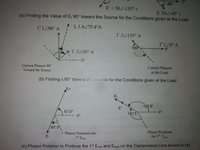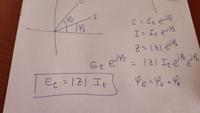Any idea how to work these problems
- Thread starter Steven G
- Start date
yoscar04
Full Member
- Joined
- Jun 3, 2020
- Messages
- 274
Are they talking about a AC specific circuit? I recall there is a generalized Ohm's law for AC circuits: E=IZ, where Z is the impedance that depends on the particular circuit we are talking about, and all quantities are expressed in complex form. So, if I am not mistaken, we need to know the circuit in order to compute Z. From there we can obtain E.
D
Deleted member 4993
Guest
Treat those as pseudo vectors (in complex plane).I need to help someone with the problems below and am a bit lost. Please enlighten me.
I do understand what A/ angle symbol/ degree angle means.
Thank you!
View attachment 20482
It = 1.4<75.4o A → It = 1.4 * [cos(75.4o) + j * sin(75.4o)] A → It = 1.4 * e[j∗18075.4∗π] A
In electrical engineering (assuming problems are coming from there) the imaginary i (= −1) is replaced with j. "i" is reserved as symbol for current.
yoscar04
Full Member
- Joined
- Jun 3, 2020
- Messages
- 274
The thing is to connect the E+ and E- to get the impedance Z. Do they say what are E+ and E-?Are they talking about a AC specific circuit? I recall there is a generalized Ohm's law for AC circuits: E=IZ, where Z is the impedance that depends on the particular circuit we are talking about, and all quantities are expressed in complex form. So, if I am not mistaken, we need to know the circuit in order to compute Z. From there we can obtain E.
After talking to friends they told me that it looks like a transmission line.

I hope this will help you a bit. I apologize I can't provide more help. Maybe someone from the forum with a more electric engineering background can enlighten us more.
Attachments
Last edited:
D
Deleted member 4993
Guest
These are called phasors (as opposed to vectors, scalars or tensors). Please come back - showing your work - if you have more questions.Yes, I found out that this is from EE.


